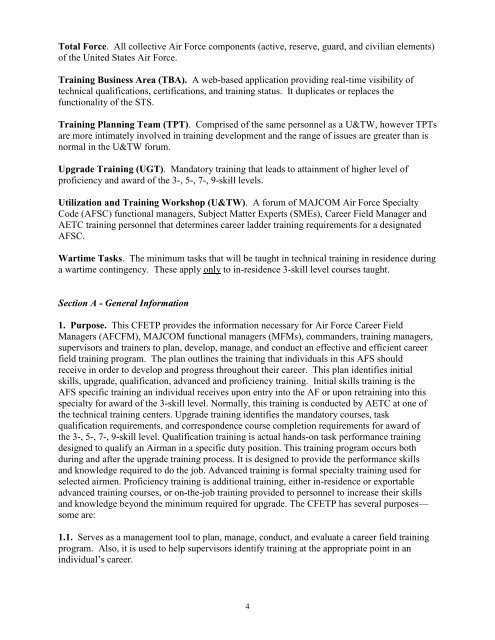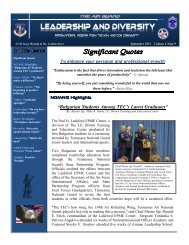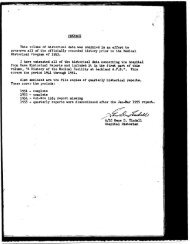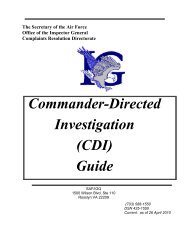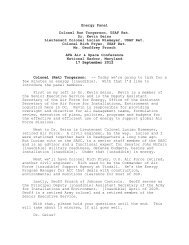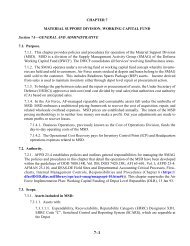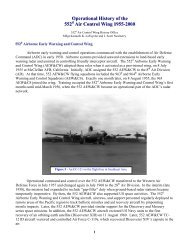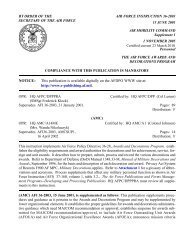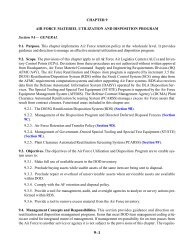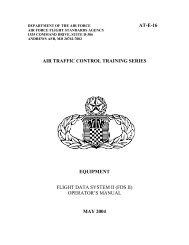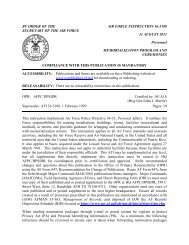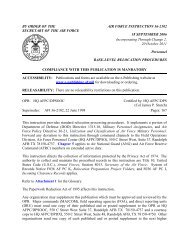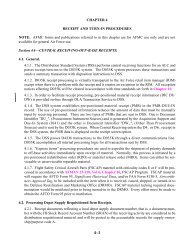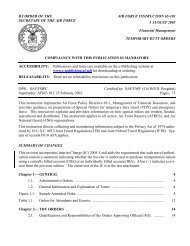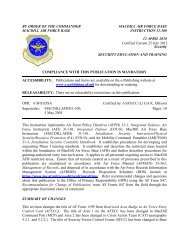AFSC 2W1X1 AIRCRAFT ARMAMENT SYSTEMS ... - Air Force Link
AFSC 2W1X1 AIRCRAFT ARMAMENT SYSTEMS ... - Air Force Link
AFSC 2W1X1 AIRCRAFT ARMAMENT SYSTEMS ... - Air Force Link
Create successful ePaper yourself
Turn your PDF publications into a flip-book with our unique Google optimized e-Paper software.
Total <strong>Force</strong>. All collective <strong>Air</strong> <strong>Force</strong> components (active, reserve, guard, and civilian elements)<br />
of the United States <strong>Air</strong> <strong>Force</strong>.<br />
Training Business Area (TBA). A web-based application providing real-time visibility of<br />
technical qualifications, certifications, and training status. It duplicates or replaces the<br />
functionality of the STS.<br />
Training Planning Team (TPT). Comprised of the same personnel as a U&TW, however TPTs<br />
are more intimately involved in training development and the range of issues are greater than is<br />
normal in the U&TW forum.<br />
Upgrade Training (UGT). Mandatory training that leads to attainment of higher level of<br />
proficiency and award of the 3-, 5-, 7-, 9-skill levels.<br />
Utilization and Training Workshop (U&TW). A forum of MAJCOM <strong>Air</strong> <strong>Force</strong> Specialty<br />
Code (<strong>AFSC</strong>) functional managers, Subject Matter Experts (SMEs), Career Field Manager and<br />
AETC training personnel that determines career ladder training requirements for a designated<br />
<strong>AFSC</strong>.<br />
Wartime Tasks. The minimum tasks that will be taught in technical training in residence during<br />
a wartime contingency. These apply only to in-residence 3-skill level courses taught.<br />
Section A - General Information<br />
1. Purpose. This CFETP provides the information necessary for <strong>Air</strong> <strong>Force</strong> Career Field<br />
Managers (AFCFM), MAJCOM functional managers (MFMs), commanders, training managers,<br />
supervisors and trainers to plan, develop, manage, and conduct an effective and efficient career<br />
field training program. The plan outlines the training that individuals in this AFS should<br />
receive in order to develop and progress throughout their career. This plan identifies initial<br />
skills, upgrade, qualification, advanced and proficiency training. Initial skills training is the<br />
AFS specific training an individual receives upon entry into the AF or upon retraining into this<br />
specialty for award of the 3-skill level. Normally, this training is conducted by AETC at one of<br />
the technical training centers. Upgrade training identifies the mandatory courses, task<br />
qualification requirements, and correspondence course completion requirements for award of<br />
the 3-, 5-, 7-, 9-skill level. Qualification training is actual hands-on task performance training<br />
designed to qualify an <strong>Air</strong>man in a specific duty position. This training program occurs both<br />
during and after the upgrade training process. It is designed to provide the performance skills<br />
and knowledge required to do the job. Advanced training is formal specialty training used for<br />
selected airmen. Proficiency training is additional training, either in-residence or exportable<br />
advanced training courses, or on-the-job training provided to personnel to increase their skills<br />
and knowledge beyond the minimum required for upgrade. The CFETP has several purposes—<br />
some are:<br />
1.1. Serves as a management tool to plan, manage, conduct, and evaluate a career field training<br />
program. Also, it is used to help supervisors identify training at the appropriate point in an<br />
individual’s career.<br />
4


